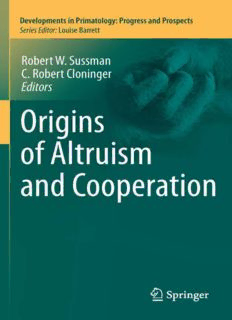
Origins of Altruism and Cooperation PDF
Preview Origins of Altruism and Cooperation
Developments in Primatology: Progress and Prospects SeriesEditor LouiseBarrett Forfurthervolumes: http://www.springer.com/series/5852 · Robert W. Sussman C. Robert Cloninger Editors Origins of Altruism and Cooperation 123 Editors RobertW.Sussman C.RobertCloninger DepartmentofAnthropology DepartmentofPsychiatry WashingtonUniversity WashingtonUniversity St.Louis,MO63130,USA SchoolofMedicine [email protected] St.Louis,MO63110,USA [email protected] ISBN978-1-4419-9519-3 e-ISBN978-1-4419-9520-9 DOI10.1007/978-1-4419-9520-9 SpringerNewYorkDordrechtHeidelbergLondon LibraryofCongressControlNumber:2011932917 ©SpringerScience+BusinessMedia,LLC2011 Allrightsreserved.Thisworkmaynotbetranslatedorcopiedinwholeorinpartwithoutthewritten permission of the publisher (Springer Science+Business Media, LLC, 233 Spring Street, New York, NY10013,USA),exceptforbriefexcerptsinconnectionwithreviewsorscholarlyanalysis.Usein connectionwithanyformofinformationstorageandretrieval,electronicadaptation,computersoftware, orbysimilarordissimilarmethodologynowknownorhereafterdevelopedisforbidden. Theuseinthispublicationoftradenames,trademarks,servicemarks,andsimilarterms,eveniftheyare notidentifiedassuch,isnottobetakenasanexpressionofopinionastowhetherornottheyaresubject toproprietaryrights. Printedonacid-freepaper SpringerispartofSpringerScience+BusinessMedia(www.springer.com) WededicatethisbooktoWalterGoldschmidt whoremindedusattheconferencethat: “Youtalkaboutcooperationandaltruism, butwhatyoureallymeanisLOVE.We shouldn’t beafraidtousethewordLOVE. Thatiswhatmakesustrulyhuman.” ThisisBlankPageIntegra vi Preface This book is derived from a conference entitled “Man the Hunted and the Origin and Nature of Human Sociality, Altruism and Well-Being” held at Washington University, March, 2009. Authors include academics from around the world and across multiple disciplines—anthropology, psychiatry, human evolution, biology, psychology, religion, philosophy, education, and medicine—to focus on the evo- lution of cooperation, altruism, and sociality and possible factors that led to the evolutionofthesecharacteristicsinnonhumanprimatesandhumans. Thetraitsofaltruismandcooperationoftenareassumedtobeamonghumanity’s essential and defining characteristics. However, it has been difficult to account for theoriginsandevolutionofaltruisticbehavior.Recently,scientistshavefounddata onaltruisticbehaviorinmanyanimalspecies,aswellasinhumansocieties,thatdo notconformtoevolutionarymodelsbasedsolelyoncompetitionandtheevolution- arydrivetopassonselfishgenes.Inthisvolume,recentdebatesaboutthenatureand originsofcooperativebehaviorsarereviewed.Thehypothesisthatunselfishcoop- erativebehaviorhasevolvedinanimalsthatliveinsocialgroupsisdiscussed.Many of the mechanisms that primates and humans have evolved for protection against predators,includingcooperationandsocialityareexplored. Social animals, including primates and humans, are not forced to live socially but do so because it benefits them in numerous ways. Through natural selection, primatesandhumanshavedevelopedareasofthebrainthatrespondtobeingcooper- ativeoraltruisticaspleasantandsatisfyingactivities.Dataarepresentedsupporting the idea that the normal pattern for most diurnal primates and for humans is to be social.Peoplewhodeveloptheneedforpsychiatricinterventionarethosewhohave become alienated and antisocial. It is human nature to want to work together and cooperate. A hypothesis is developed that well-being is inseparable from positive socialinteraction. Alldiurnalprimatesliveinsocialgroups.Thisiswidelyrecognizedasapreda- torprotectionmechanism.Themoreeyesandearstodetectpredatorsandthemore animals to mob them, the better the group is protected. Early humans have tra- ditionally been thought of as hunters. However, because of their relatively small size, dental morphology, lack of hunting tools, and a number of other factors, it is more likely that the earliest humans, like most other primates, were prey vii viii Preface species rather than predators. Sociality, cooperation, inter-individual dependency, andmutualprotectionareallpartofthetoolkitofsocial-livingprey. Watchingthe5o’clocknewsregularly,youmightthinkthathumanswereborn to be destructive, violent, and antagonistic. But this is not the case. The evidence leads to the conclusion that cooperative and altruistic behaviors are not just by- products of competition but rather are essential ingredients in evolution, ecology, anddevelopment,andarethegluethatunderliestheabilityforprimatesandhumans to live together in groups. The paleontological, behavioral, neurobiological, and psychologicalevidenceprovidedinthisbookgivesamoreoptimisticandrealistic view of human nature than the more popular, conventional view of humans being naturally and basically aggressive and warlike. Competition and aggressive self- preservationareadefinitepartofthebehavioralrepertoireofallmammals,butthey are primitive tendencies that are progressively regulated by higher cognitive pro- cessesincreasingthecapacityforcooperation,whichemergedinastepwisefashion intheevolutionofnonhumanprimatesandhumanbeingsfromtheircommonances- tors.Theevidencedescribedinthisbookfrommanyfieldsindicatesthatcooperation andaltruismarethestatisticalnormandrepresentthemoretypical,“normal,”spon- taneous(ornatural)andhealthybehavioralpatterninprimates.Infact,cooperative socialityisanecessityforwell-beinginanthropoidprimates. Inthisvolume,theauthorsreviewrecentdebatesaboutthenatureandoriginsof cooperative behavior. They test the hypothesis that unselfish cooperative behavior hasevolvedingroup-livinganimals.Finally,theyexplorethishypothesisandmany of the mechanisms nonhuman primates and humans may have evolved as protec- tionagainstpredators,includingcooperationandsociality.Theauthorsdiscusshow behavioral, hormonal, neuropsychiatric, and developmental mechanisms related to our evolution as a prey species might be affecting modern human and nonhuman primatebehaviors. Socialscientistsandbiologistsarelearningthatthereismoretocooperationand generosity in both human and nonhuman group-living animals than an investment in one’s own nepotistic patch of DNA. Research in a great diversity of scientific disciplines is revealing that there are many biological and behavioral mechanisms that humans and nonhuman primates use to reinforce pro-social or cooperative behavior.Forexample,therearespecificneurobiologicalandhormonalmechanisms thatsupportsocialbehavior.Therearealsopsychological,psychiatric,andcultural mechanisms.However,therehasbeenlittleinteractionamongresearchersworking onthesesubjectsfromdifferentdisciplines.Giventhatlittleinterchangehastaken place among the scientists conducting this research, there have been few attempts to synthesize this material or to carry out interdisciplinary projects on this sub- ject.Inthisbook,theauthorswilldescribeinterdisciplinaryresearchandsynthesize currentlyavailableinformation. The book moves theoretical anthropology forward by integrating, synthesizing, and providing new hypotheses and a better understanding of the proximate and evolutionary underpinnings of human cooperative behavior, altruism, and social- ity.Thereisabundantevidenceforbothsocialcooperationandviolenceinhuman history. Alternative theories make different predictions about the determinants of Preface ix both social and antisocial behaviors in primates. Some primatologists suggest that humansarenaturallyaggressiveandviolentinmostsituations,sothatcooperation isinfrequentandexternallyforced.Otherssuggestthathumanbeingsare“bipolar apes” with conflicting dispositions for waging war (like aggressive chimpanzees) and making love (like sociable bonobos), so that human beings must constantly strivetoengageinemotionalreconciliationtomaintainsocialharmony.Wesuggest that human beings are naturally cooperative when healthy and only revert to vio- lenceunderabnormalconditions,aswhenstressed,abused,neglected,ormentally ill.Readerswillhaveanopportunitytoconsidertheevidenceneededtodistinguish amongthesealternativetheoriesofhumannature.Inashrinkingworld,theproper mechanismsforfuturepeacefulglobalinteractionsnecessitateabetterunderstand- ing of how, when, and why humans cooperate. Anthropology should provide a synthesis of this diverse body of knowledge and we hope that this volume helps movesusinamoreoptimisticdirection. The book is intended both for the general reader and for students at a variety of levels (graduate and undergraduate): it aims to provide a compact, accessible, andup-to-dateaccountofthecurrentscholarlyadvancesanddebatesinthisfieldof study,anditisdesignedtobeusedinteachingandindiscussiongroups.Theconfer- encefromwhichthisvolumeoriginatedwassponsoredbyN.S.F.,theWenner-Gren Foundation for Anthropological Research, the Washington University Committee for Ethics and Human Values, and the Anthropedia Foundation for the study of well-being. St.Louis,Missouri RobertW.Sussman C.RobertCloninger
Description: